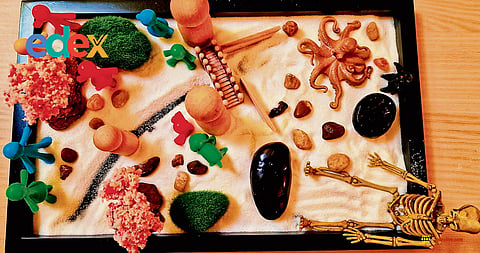

Sometimes when words are not enough, art finds a way to speak for us. For Aswathy Krishnakumar, a clinical psychologist and art psychotherapist based in Thiruvananthapuram, this belief forms the heart of her practice.
Aswathy will be conducting a free art psychotherapy session — ‘a taster session’ as she calls it — in Kochi at Thudippu Dance Foundation, Vennala, on October 19. She aims to give people a glimpse into how art can be used as a tool for healing and emotional expression.
The session will mark the first in a series of such workshops across Kerala.
“Art psychotherapy doesn’t test your artistic abilities,” Aswathy clarifies. “If you feel like scribbling or even tearing a piece of paper, that is fine too. What matters is that you are emoting through art.”
The essence of art psychotherapy is not in creating something beautiful but in the process itself. The therapist observes the process, without interpreting or judging, and gently guides the client towards understanding their emotions.
“My role is not to judge, but to help you understand why you drew it,” she says. “It’s all about the process.”
Aswathy’s journey with art therapy began during the pandemic. “I was part of the government’s counselling cell during Covid, speaking to people who were distressed and anxious. Art and painting helped me release my own emotions after those long calls,” she recalls. “That’s when I discovered that this could be studied as a proper discipline.”
She soon travelled to the UK to pursue a Master’s in Art Psychotherapy from the University of Chester. During her training, Aswathy worked with women refugees from Ukraine and Afghanistan, many of whom did not speak English; the experience provided her with a much-needed lesson in non-verbal communication.
“We built a small community where they would paint or crochet together. I could not speak to them directly, but it taught me how deeply we could still connect without words.”
Returning to Kerala was always part of Aswathy’s plan. However, there was a challenge, as what she had studied in British art therapy was culturally rooted in Western artistic traditions. She now had to adapt her learning to Indian and Malayali contexts.
For instance, her nature art therapy sessions have been adapted to Kerala’s accessible outdoors. “We don’t use paper or materials that harm nature,” she explains. “We use what is available around us, like leaves, twigs, stones, and sand, and create artworks using them.”
Ashwathy believes that therapy is not limited to talking for an hour. There are other ways to understand ourselves. Her dream project, Oridam (which means ‘a space’ in Malayalam), embodies this vision: a space where people can come and process their emotions in different ways. “Right now, Oridam is something I carry with me wherever I go,” she smiles.
For the 30-year-old art therapist, regardless of your artistic skills, art psychotherapy is open to everyone and any kind of expression. “You don’t have to paint,” she says. “We can work with clay, embroidery, crochet, and even Lego! I once had a client with post traumatic stress disorder who preferred using Lego bricks. Over time, we moved to origami, and he loved the shift from something rigid to something delicate.”
Aswathy notes that conversations around mental health have evolved significantly in recent years. She notes, “There was a time when people thought only medication could help. But we now understand that mental health care has to be holistic. Art therapy doesn’t replace conventional therapy; it complements it.”
“You don’t have to find the right words. You just have to start,” Aswathy insists.
[Article by Supriya of The New Indian Express]
